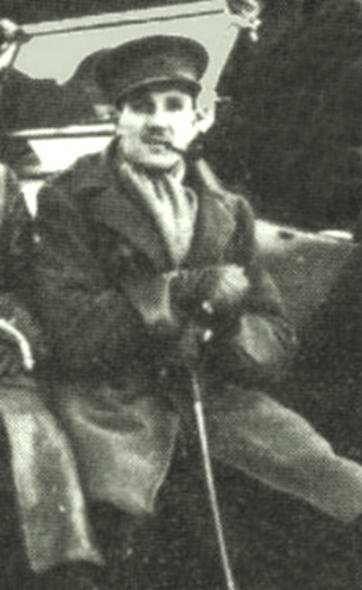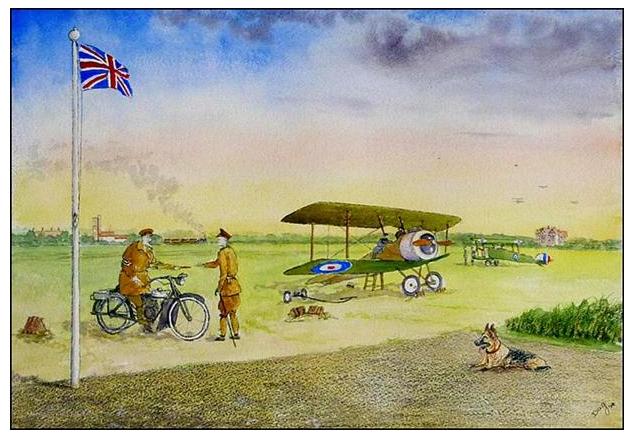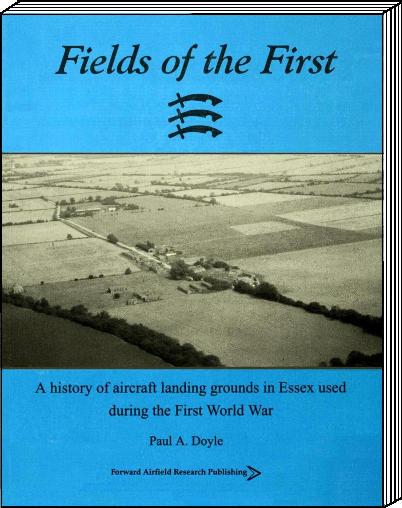|
37-Squadron Night
Landing Grounds |
|||
|
Pilots from the
Goldhanger Flight Station were known to occasionally used a “Night Landing
Ground” near the village of Easthorpe and close to the London Road (now the A12)
between Kelvedon and Marks Tey. Little is known about the site, other than it
comprised of a grass strip, tents, a fuel storage tank and a wind sock. The
Royal Flying Corps 37-Squadron acquired twelve of these landing sites in the
vicinity, managed from their headquarters at The Grange on the
Southend Rd. in Woodham Mortimer. The Easthorpe site was the nearest one to
the Goldhanger Flight Station and we have the incident records of two Flying
Officers based at Goldhanger who used the Easthorpe landing ground... |
|||
|
2nd Lt Armstrong
took off from Goldhanger at 23:00 on 17th February 1918 in response to a raid
by a single Giant Bomber that was destined to bomb London. For 2 hours, he
patrolled from Goldhanger to Easthorpe.
Then Armstrong’s BE-12 aircraft crashed in a field in Tolleshunt Major. The
aircraft burst into flames killing 2nd Lt Armstrong. 2nd Lt Armstrong
is buried in a military grave Goldhanger churchyard, his name is on the
Goldhanger War Memorial and is also on the Stow Maries memorial. |
|
||
|
|
The second incident is recorded in the... Goldhanger Flight Station Operational
Records “37-Squadron attempted to intercept Zeppelin
L42 but
were frustrated by the weather, two aircraft from Goldhanger and one from
Rochford, airborne after early reports of Zeppelins off the Suffolk coast
were forced back by the conditions. Captain William Sowery broke his propeller and the
lower wing while landing in poor visibility. His second sortie in another
aircraft was cut short when a sooted spark plugs forced him down at Easthorpe. The Operational
Records of 32 Goldhanger incidents can be seen... here |
||
|
This map identifies
the locations of 37-Squadron’s Landing Grounds in relation to the Squadron’s
Flight Stations... |
|||
|
Flight Stations and
Landing Grounds were categorised the RFC according to their day and night
time capabilities: First Class
Landing Ground – Several buildings, hangars and accommodation Second Class
Landing Ground – a permanent hangar, and a few huts Third Class
Landing Ground – a temporary “Bessonneau” hangar Emergency Landing
Ground – often a field, requested by telephone call to the farmer, requesting he
moved away grazing animals Night Landing
Grounds - lit with perimeter lights and/or have a “flarepath”, these were provided
to support attacks on night time Zeppelin raids. for more
information about this see... https://en.wikipedia.org/wiki/Royal_Flying_Corps |
|||
|
One can only
wonder why the Easthorpe was chosen as a suitable site... Several factors
would have been taken into account: o The distance from existing flight stations
to provide the best opportunity to land in an emergency or when low on fuel.
By today’s standards very small amounts of fuel were used as the bi-planes
had to keep weight down to reach the cruising height of the Zeppelins, so
there was a high risk of running out of fuel. o Flat land with established grass and easy access
by road or a hard gravel surface was essential, there would have been no time
to develop a site. o The absence of houses and large trees in
the immediate vicinity, but with telephone wires nearby. ...and how did
the site operate if there were no buildings or permanent occupation? One can assume
that at the same time that a flight took off from the Flight Station a ground
crew would set off for the night landing ground, probably on motorcycles, and
on arrival would send up flairs and position their headlights to point along
the grass indicating the location and direction of the landing strip. There
would have had a tank of fuel available and the crew would assisted the pilot
to refuel using small cans to convey the fuel to the aircraft, and then carry
out any minor repairs. |
|||
|
Immediately after
the war the Easthorpe field would have been handed back to the farmer, and as
no buildings were put up there, nothing remained. Here is a 1925 map showing
just a field and a recent satellite view of the same location... |
|||
|
Between the 1950s and 2015 the
field became the Marks Tey Point-to-Point track, and since then it has been
the site of the Colchester Model Aircraft and Model Car Clubs. |
|||
|
We can however, visualise what the Easthorpe
landing ground would have looked like in its heyday as we have an artist’s impression
of what the Rochford site was like in 1915 when it too was designated as a
landing ground with no buildings on the site... Within a few months Rochford
was upgraded to a Flight Station and in 1917 RFC became a Night Flying
Training Station as part of 61-Sqdn. Ever since then the airfield has had an remarkable
evolution: 1939 RAF Fighter Command 1945 Southend municipal airport 2008 London-Southend International Airport |
|||
|
These websites
may be useful for further investigation... https://www.abct.org.uk/airfields/airfield-finder |
|||
|
...and
the definitive book on this subject is... Fields of the First by
Paul Doyle published in 1997 a
history of the WW1 landing fields in Essex |
|
||
|
back to... |
|||
|
Goldhanger Flight Station Zeppelin
Busters over the Blackwater
home |
|||




